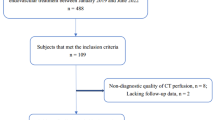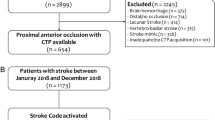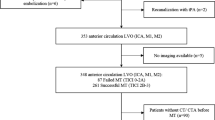Abstract
Purpose
The effect of pretreatment infarct location on clinical outcome after successful mechanical thrombectomy is not understood. Our aim was to evaluate the association between computed tomography perfusion (CTP)-based ischemic core location and clinical outcome following excellent reperfusion in late time windows.
Methods
We retrospectively reviewed patients who underwent thrombectomy for acute anterior circulation large vessel occlusion in late time windows from October 2019 to June 2021 and enrolled 65 patients with visible ischemic core on admission CTP who had received excellent reperfusion (modified thrombolysis in cerebral infarction grade 2c/3). Poor outcome was defined as a modified Rankin scale score of 3–6 at 90 days. The ischemic core infarct territories were classified into the cortical and subcortical areas. Multivariate logistic regression and receiver operating characteristic (ROC) curve analyses were used in this study.
Results
Of the 65 patients analyzed, 38 (58.5%) had a poor outcome. Multivariable logistic analysis showed that the subcortical infarcts (OR 11.75; 95% CI 1.79–77.32; P = 0.010) and their volume (OR 1.17; 95% CI 1.04–1.32; P = 0.011) were independently associated with poor outcome. The ROC curve indicated the capacity of the subcortical infarct involvement (areas under the curve (AUC) = 0.65; 95% CI, 0.53–0.77, P < 0.001) and subcortical infarct volume (AUC = 0.72; 95% CI, 0.60–0.83, P < 0.001) in predicting poor outcome accurately.
Conclusion
Subcortical infarcts and their volume on admission CTP are associated with poor outcome after excellent reperfusion in late time windows, rather than cortical infarcts.



Similar content being viewed by others
Data availability
The data that support the findings of this study are available from the corresponding author upon reasonable request.
References
Goyal M, Menon BK, van Zwam WH et al (2016) Endovascular thrombectomy after large-vessel ischaemic stroke: a meta-analysis of individual patient data from five randomised trials. Lancet 387:1723–1731
Powers WJ, Rabinstein AA, Ackerson T et al (2019) Guidelines for the early management of patients with acute ischemic stroke: 2019 update to the 2018 guidelines for the early management of acute ischemic stroke: a guideline for healthcare professionals from the American Heart Association/American Stroke Association. Stroke 50:e344–e418
Albers GW, Marks MP, Kemp S et al (2018) Thrombectomy for stroke at 6 to 16 hours with selection by perfusion imaging. N Engl J Med 378:708–718
Nogueira RG, Jadhav AP, Haussen DC et al (2018) Thrombectomy 6 to 24 hours after stroke with a mismatch between deficit and infarct. N Engl J Med 378:11–21
Casetta I, Fainardi E, Saia V et al (2020) Endovascular thrombectomy for acute ischemic stroke beyond 6 hours from onset: a real-world experience. Stroke 51:2051–2057
Campbell BCV, Majoie C, Albers GW et al (2019) Penumbral imaging and functional outcome in patients with anterior circulation ischaemic stroke treated with endovascular thrombectomy versus medical therapy: a meta-analysis of individual patient-level data. Lancet Neurol 18:46–55
Demeestere J, Scheldeman L, Cornelissen SA et al (2018) Alberta stroke program early CT score versus computed tomographic perfusion to predict functional outcome after successful reperfusion in acute ischemic stroke. Stroke 49:2361–2367
Ospel JM, Menon BK, Qiu W et al (2021) A detailed analysis of infarct patterns and volumes at 24-hour noncontrast ct and diffusion-weighted MRI in acute ischemic stroke due to large vessel occlusion: results from the ESCAPE-NA1 Trial. Radiology 300:152–159
Ernst M, Boers AMM, Forkert ND et al (2018) Impact of ischemic lesion location on the mRS score in patients with ischemic stroke: a voxel-based approach. AJNR Am J Neuroradiol 39:1989–1994
Ernst M, Boers AMM, Aigner A et al (2017) Association of computed tomography ischemic lesion location with functional outcome in acute large vessel occlusion ischemic stroke. Stroke 48:2426–2433
Tolhuisen ML, Ernst M, Boers AMM et al (2022) Value of infarct location in the prediction of functional outcome in patients with an anterior large vessel occlusion: results from the HERMES study. Neuroradiology 64:521–530
Gauberti M, Lapergue B, Martinez de Lizarrondo S et al (2018) Ischemia-reperfusion injury after endovascular thrombectomy for ischemic stroke. Stroke 49:3071–3074
Dargazanli C, Fahed R, Blanc R et al (2018) Modified thrombolysis in cerebral infarction 2C/thrombolysis in cerebral infarction 3 reperfusion should be the aim of mechanical thrombectomy: insights from the ASTER Trial (Contact Aspiration Versus Stent Retriever for Successful Revascularization). Stroke 49:1189–1196
Ghozy S, Kacimi SEO, Azzam AY et al (2022) Successful mechanical thrombectomy in acute ischemic stroke: revascularization grade and functional independence. J Neurointerv Surg 14:779–782
Campbell BC, Christensen S, Levi CR et al (2011) Cerebral blood flow is the optimal CT perfusion parameter for assessing infarct core. Stroke 42:3435–3440
Hacke W, Kaste M, Fieschi C et al (1998) Randomised double-blind placebo-controlled trial of thrombolytic therapy with intravenous alteplase in acute ischaemic stroke (ECASS II). Second European-Australasian Acute Stroke Study Investigators. Lancet 352:1245–1251
Cheng B, Forkert ND, Zavaglia M et al (2014) Influence of stroke infarct location on functional outcome measured by the modified rankin scale. Stroke 45:1695–1702
Munsch F, Sagnier S, Asselineau J et al (2016) Stroke location is an independent predictor of cognitive outcome. Stroke 47:66–73
Wu O, Cloonan L, Mocking SJ et al (2015) Role of acute lesion topography in initial ischemic stroke severity and long-term functional outcomes. Stroke 46:2438–2444
Regenhardt RW, Etherton MR, Das AS et al (2021) White matter acute infarct volume after thrombectomy for anterior circulation large vessel occlusion stroke is associated with long term outcomes. J Stroke Cerebrovasc Dis 30:105567
Loh Y, Towfighi A, Liebeskind DS et al (2009) Basal ganglionic infarction before mechanical thrombectomy predicts poor outcome. Stroke 40:3315–3320
Haussen DC, Ferreira IM, Barreira C et al (2018) Active reperfusion hemorrhage during thrombectomy: angiographic findings and real-time correlation with the CT "spot sign". Interv Neurol 7:370–377
Liebeskind DS (2005) Collaterals in acute stroke: beyond the clot. Neuroimaging Clin N Am 15(553-573):x
Funding
This research received no specific grant from any funding agency in the public, commercial, or not-for-profit sectors.
Author information
Authors and Affiliations
Corresponding author
Ethics declarations
Conflict of interest
The authors declare that they have no conflict of interest.
Ethical approval
All procedures performed in the studies involving human participants were in accordance with the ethical standards of the institutional research committee and with the 1964 Helsinki Declaration and its later amendments or comparable ethical standards.
Informed consent
Based on the retrospective study design, the requirement for patient informed consent for study inclusion was waived.
Additional information
Publisher’s note
Springer Nature remains neutral with regard to jurisdictional claims in published maps and institutional affiliations.
S Liu and LB Zhao contributed equally to this work and are listed as co-corresponding authors.
Supplementary information
ESM 1
(PDF 161 kb)
Rights and permissions
Springer Nature or its licensor (e.g. a society or other partner) holds exclusive rights to this article under a publishing agreement with the author(s) or other rightsholder(s); author self-archiving of the accepted manuscript version of this article is solely governed by the terms of such publishing agreement and applicable law.
About this article
Cite this article
Ni, H., Hang, Y., Wang, CD. et al. Subcortical infarcts on admission CTP predict poor outcome despite excellent reperfusion in delayed time windows. Neuroradiology 65, 1247–1254 (2023). https://doi.org/10.1007/s00234-023-03172-3
Received:
Accepted:
Published:
Issue Date:
DOI: https://doi.org/10.1007/s00234-023-03172-3




